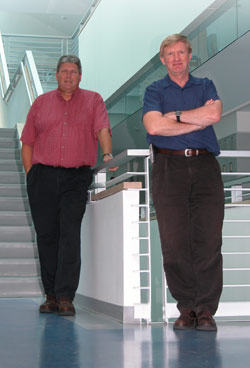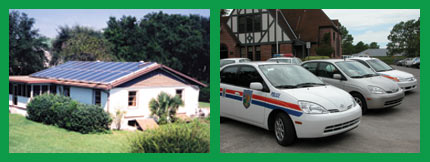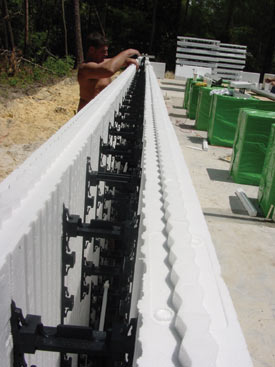article
by Aaron Hoover downloadable
.pdf
The
nation’s 76 million residential and five million commercial
buildings consume 68 percent of its electricity, 40 percent
of its raw materials and 88 percent of its drinking water.
They account for a third of U.S. municipal solid waste and
produce a third of its pollution.
So
many have been blamed for illness that the Environmental Protection
Agency lists indoor air quality among its top five environmental
health risks.
 |
| UF
sustainability director David Newport (left) and building
construction Professor Charles Kibert are leaders in the
concepts of a carbon-neutral campus and environmentally
sensitive construction projects. |
Literally,
the environmental and health costs of buildings have been
going through the roof. To contain them, the construction
industry has begun to embrace a new trend known as “green
building.” The burgeoning movement traces its roots
to research at the University of Florida.
And
UF’s involvement goes beyond the intellectual. The university
cemented its commitment to green-building practices earlier
this year when it dedicated Rinker Hall.
The
$10-million, 47,270-square-foot home to UF’s School
of Building Construction, Rinker Hall was designed to use
half the electricity of other buildings its size and just
a fraction of the water. Most of its components were recycled,
or came from responsibly managed forests, or can someday be
reused in another building. Inside Rinker’s three stories,
with space for 450 students, the classrooms, labs and offices
were built with materials selected because they don’t
emit chemicals tied to so-called sick building syndrome —
with other steps ensuring against mold or other biological
pathogens.
Situated
at the heart of campus, Rinker Hall’s abundant windows,
airy classrooms and sky-lit atrium make it look more pleasant
than futuristic.
That’s
just the way it was planned, says Charles Kibert, a green-building
pioneer who recently stepped down as chair of the School of
Building Construction: “This whole building was done
to serve as an example — a pilot project for green building.”

Rinker
Hall crests a new wave of environmental progressivism on the
UF campus. But campus-based experimentation with environmentally
sensitive alternatives dates to at least 1954, when UF established
one of the first solar research parks in the nation. Designated
a historic site by the American Society of Mechanical Engineers
last year, the Solar Energy and Energy Conversion Laboratory
spawned experiments in solar energy on and off campus in the
1970s and 1980s. Solar hot-water heaters and other instruments
appeared at residence halls, swimming pools, Shands Hospital,
even a photo processing lab and a coin laundry. One massive
off-campus project sought to heat and cool Gainesville’s
airport using 744 solar panels covering 16,000 feet of rooftop.
Gainesville was so well known for
solar experimentation that Mother Earth News called it the
“Solar Capital of the World” in a 1974 publication.
 |
| The
Solar House at UF’s Energy Research and Education
Park. The house was moved to this site in the 1970s.
While no longer used as a residence, ongoing experimentation
continues within it. The house is also the site
of the Erich A. Farber Archives. |
The
University Police Department has three Toyota Prius
hybrid vehicles that operate on combination gasoline-electric
engines that deliver more than 48 miles per gallon. |
|
UF’s
solar-park research launched numerous commercial products,
such as solar-assisted heating and air conditioning systems.
The university remains a leader in solar research and continues
to flirt with solar technology. Most recently, a group of
students has launched an initiative to install photovoltaic
cells on UF building rooftops.
In
the nearly 50 years since the solar park opened, the environmental
ethic has spread to many parts of campus. Much of the recent
activity dates to 1997, when a grassroots group of students
and faculty founded “Greening UF” to encourage
“sustainable” thinking and practices. In other
words, using resources to provide for today’s needs
without compromising future generations.
The
Greening UF movement spurred UF to become the nation’s
first public university to publish a “Sustainability
Indicators Report” under the Global Reporting Initiative
in 2001. The initiative, a voluntary program affiliated with
the United Nations, expands the information that companies
and institutions report to include not only financial indicators
but also environmental and social ones.
Last
year, the UF Sustainability Task Force, an advisory group
and outgrowth of Greening UF, issued a 19-page report calling
for a series of sweeping environmental and energy conservation
measures. These included managing UF lands to ensure biodiversity,
buying a low-emission vehicle fleet and including green considerations
in UF’s investment decisions.
UF
also is the nation’s only public university with an
active program to become “carbon neutral” —
to reduce to zero the amount of carbon dioxide and other greenhouse
gases the university contributes to the atmosphere. The person
heading up the project, Dave Newport, has the unique title
“Director of Sustainability.”
A
longtime environmental magazine publisher, Newport was elected
to the Alachua County Commission in 1998 on a strong environmental
platform. With two other like-minded commissioners, he racked
up such green triumphs as Alachua Forever, a $29 million taxpayer-funded
land conservation program. But since losing a reelection bid
last year, Newport has thrown his passions behind another
goal — cutting in half the amount of electricity UF
consumes.

Sitting
in his third floor office in Rinker, Newport explains that
more than 80 percent of UF’s greenhouse gas contributions
stem from the production of electricity to heat, cool and
light the campus’ more than 900 buildings. Pollution
isn’t the only negative. The light bill for the university
and its 60,000 students, faculty and staff is $75,000 a day.
Newport
is recommending that UF chip away at its power appetite by
creating a revolving fund for energy efficiency retrofits
to accompany renovations or expansions. The energy savings
from each retrofit would reimburse the fund for the next project.
He’s also pushing to make energy efficiency a financial
consideration in UF’s selection of building contracts.
That would be a sea change. Public institutions in Florida
separate capital cost from operating cost, which means the
lowest bid wins the contract — even if the building’s
electricity bill winds up costing taxpayers more in the long
term. Indeed, Rinker’s efficiency upgrades added about
$1 million to its total cost.
Newport,
who is working closely with UF energy specialist Jeff Johnson
on the project, admits he has no authority — other than
President Charles Young’s mandate to make UF “a
global leader in sustainability.”
So
one of his first steps is a high-tech appeal to common sense.
He’s created a searchable online database that allows
users to see how much electricity each of UF’s buildings
currently consumes — and how much could be saved if
the building received efficiency upgrades.
“What
is cool about it is that you can spend so many dollars on
a building on energy efficiency measures and put those in
the database, and it will calculate how much less power the
building will use, and how long it will be before the payback,”
he says.
As
Newport’s efforts build on campus, others are advocating
green concepts statewide and nationally. For example, the
Florida Energy Extension Service, part of the UF Institute
of Food and Agricultural Sciences, has set up a partnership
with a Gainesville contractor to build and sell ultra-environmentally
friendly homes.
The
goal of the eight-home project at the 88-home Madera subdivision
is to prove to home builders that green homes can also earn
money.
“We’re
essentially building homes that have significant green characteristics
and are also fully integrated into a commercial, for-profit
development venture,” says Pierce Jones, a UF professor
of agricultural and biological engineering who serves as assistant
director of the Florida Energy Extension Service.
“We want consumers to choose green features because
they recognize their true value. And we want these upgrades
to be profitable for the builders, so they’ll keep offering
them.”
The
homes will burst with energy-saving or environmentally friendly
features. Options include insulated concrete form walls, built
with concrete and insulation for a super-insulating effect;
floors made of renewable bamboo; energy-efficient fluorescent
lights; and a water-saving washing machine and dishwasher.
Native drought-tolerant plants will replace traditional lawns.
All of Madera’s homes will meet federal “Energy
Star” standards as well as green home standards adopted
by the the Florida Green Building Coalition, a statewide green
building advocacy group Jones helped found. Thirty percent
more efficient than standard-built homes, the UF-built homes
will use just half the electricity and water of a typical
home.
Juddy
Carter, owner of Carter Construction, UF’s partner in
the project, says his hope is that the project will help get
out the word on the availability of green features and their
value to home owners.
“The
thing that interests me the most is being involved with the
cutting-edge technologies being developed today,” he
said. “We have to showcase some of that to make the
public aware.”

 A
decade ago, few people had even heard of green construction.
Today, some 100,000 Energy Star homes have been certified.
Rinker Hall, meanwhile, joins some 600 private and public
commercial buildings nationwide to be certified under a national
standard known as Leadership in Energy and Environmental Design,
or LEED. A
decade ago, few people had even heard of green construction.
Today, some 100,000 Energy Star homes have been certified.
Rinker Hall, meanwhile, joins some 600 private and public
commercial buildings nationwide to be certified under a national
standard known as Leadership in Energy and Environmental Design,
or LEED.
Kibert
pioneered many of the ideas behind the trend. As a longtime
mechanical design engineer for private companies, Kibert was
always disturbed by the amount of waste generated in the construction
industry. Building a 2,000-square-foot home can generate six
tons of waste. When he left the private sector to come to
UF in 1990, Kibert decided to try to do something about the
problem.
His
early work on construction waste quickly broadened into research
aimed at taking an environmental approach to the overall site
planning, design, construction and use of buildings. He and
other UF researchers coined the term “sustainable construction”
and were the first outside the literary world to use the term
“deconstruction” for the study of maximizing reuse
of building material.
Kibert
organized the first International Conference on Sustainable
Construction in 1994, drawing 300 people from 30 countries.
He went on to publish more than 90 papers and books, most
related to green building.
Kibert’s
research confirmed his hunch that the traditional approach
of focusing on initial costs is wrong. It causes excessive
waste during construction. It creates energy inefficiencies
that wind up making the building more expensive over the long
haul. And it leaves many occupants sick, leading to lost productivity
and other ills.
With
his colleagues at the School of Building Construction, Kibert
helped to create Summer House, a green environmental education
center at Kanapaha Botanical Gardens in Gainesville, among
other buildings. But Rinker is in many ways the most complete
physical culmination of Kibert’s ideas.
The
building’s urinals are waterless, with each saving a
remarkable 40,000 gallons annually. Its toilets flush with
rainwater collected in an 8,000-gallon cistern, and the grounds
are irrigated with reclaimed water. Carefully oriented along
a north-south axis to maximize daylight exposure, its windows,
skylights and reflective louvers make artificial light all
but unnecessary except at night. Its thin, white aluminum
exterior deflects heat rather than absorbing it, and the walls
contain three separate layers of insulation.
|
The
building’s urinals are waterless, with each saving
a remarkable 40,000 gallons annually. |
The building is in many ways recycled. Wall panels, drywall,
concrete, ceiling tile, steel products and numerous other
components contain reused materials.
Reflecting
studies that show employees are happier and more productive
in more natural settings, most offices and classrooms have
windows, and most windows open.
Kibert
says he and other planners sought to make the building environmentally
sensitive in the broadest possible sense — from the
choice of the site on a former parking lot at the center of
campus to energy use and indoor air quality. The result is
already a success in some respects. For example, more than
half of the construction waste generated when Rinker was built
was recycled. Because it has been occupied only since January,
it’s too early to determine if Rinker has achieved all
of its goals. Some information, like electricity use comparisons,
will be available soon. Other data, such as whether employees
report fewer sick days, will take longer to ferret out, Kibert
says.
The
founder and director of UF’s Powell Center for Construction
and the Environment, Kibert is at once optimistic and philosophic.
Rinker is, after all, partly an experiment in the evolving
idea of what it means to be green.
“I would hope the news will be good,” he says,
“but if it isn’t in some areas, we’ll go
back and find out why and fix them.”
Charles
Kibert
Professor of Building Construction
(352) 392-5965
ckibert@ufl.edu
David Newport
Director of Sustainability
(352) 392-5965
dnewport@ufl.edu
Pierce Jones
Assistant Professor of Agricultural and Biological Engineering
(352) 392-8074
ez@energy.ufl.edu
Related web sites
http://www.bcn.ufl.edu/rinker/rinker.shtml
http://www.sustainable.ufl.edu/oos.html
http://www.energy.ufl.edu
|


